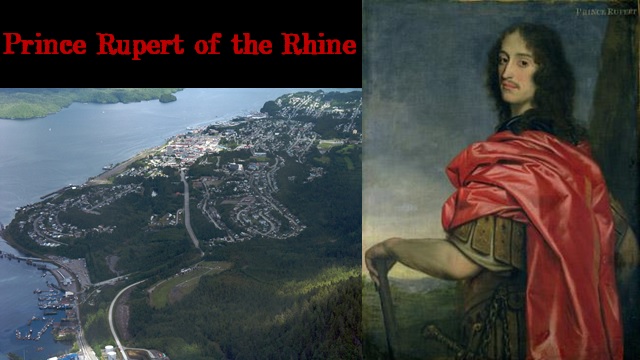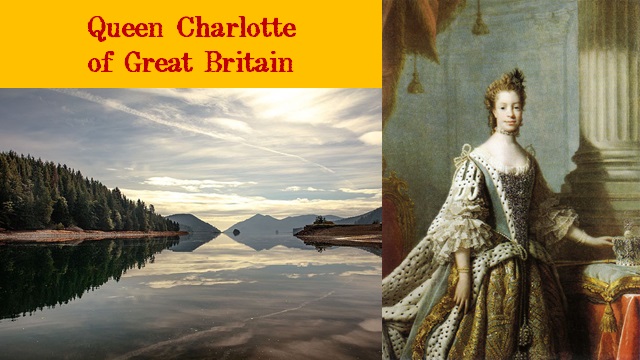Famous People Who Canadian Places are Named After
Like all countries that began as European colonies, Canada is filled with cities, regions, roads, and buildings named after once-influential people whose stories Canadians have largely forgotten. The names of these places appear so frequently in conversation that we seldom pause to consider the lives and accomplishments of the nobles, saints, and explorers in whose honour they were given. Here are a few of the folks whose names many Canadian places now bear.
Aristocrats
Prince Rupert of the Rhine (1619 – 1682)

A 17th Century German-English military commander, artist, scientist, and hero of the First English Civil War, Prince Rupert of the Rhine is the namesake of the following Canadian places:
- Prince Rupert, British Columbia- a port town on the West Coast of Central B.C.
- Prince Rupert, a residential neighbourhood in northwest Edmonton, Alberta.
- Rupert River, one of the largest rivers in Quebec, which flows into…
- Rupert Bay, a large bay situated on the southeastern shore of James Bay (the large body of water on the southern end of Hudson Bay).
- Rupert’s Land, the vast territory once controlled by the Hudson’s Bay Company, comprising the watershed of Hudson Bay.
.
Louis de Buade, Comte de Frontenac (1622 – 1698)

This 17th Century French soldier, courtier, and Governor of New France is the namesake of:
- Chateau Frontenac, a grand railway hotel located in Quebec City.
- Frontenac station, a station on the Green Line of the Montreal Metro.
- Frontenac National Park, located in southeastern Quebec.
- Fort Frontenac, a 17th Century French military fort built near the head of the St. Lawrence River.
- Frontenac Provincial Park, located north of Kingston, Ontario, in Frontenac County, Ontario.
.
King George III of Great Britain (1738 – 1820)

This controversial Hanoverian British king, who ruled from 1760 until his death in 1820, is the namesake of:
- Prince George, the so-called “Capital of Northern British Columbia”.
- The Georgia Strait, the part of the Salish sea which separates Vancouver Island from the British Columbian mainland.
- Kingston, Ontario, a large city situated on the eastern shores of Lake Ontario.
.
Queen Charlotte of Great Britain (1744 – 1818)

This wife of King George III of Great Britain is the namesake of:
- The Queen Charlotte Islands, an archipelago in the Pacific Northwest and the traditional home of the Haida First Nation, now called by its original title, “Haida Gwaii”.
- Charlottetown, the provincial capital of Prince Edward Island.
- Charlotte Street, a road in Sydney, Nova Scotia.
.
Prince Edward, Duke of Kent (1767 – 1820)

The fourth son and fifth child of King George III and Queen Charlotte of Great Britain (and the father of Queen Victoria) and the first member of the royal family to live in Canada, Prince Edward, Duke of Kent, is the namesake of:
- The Province of Prince Edward Island.
.
Queen Victoria of Great Britain (1819 – 1901)

This beloved and long-reigning 19th Century British Queen is the namesake of:
- Victoria, the provincial capital of British Columbia.
- Regina, the provincial capital of Saskatchewan.
- Victoria Island, the second-largest island in the Arctic Archipelago and the eighth largest island in the world.
- The Fairmont Empress, one of the oldest hotels in Victoria, BC.
- Victoria Hall, the historic town hall of Cobourg, Ontario.
.
Prince Albert of Saxe-Coburg and Gotha (1819 – 1861)

Consort to Queen Victoria, Prince Albert is the namesake of:
- Prince Albert, the third largest city in Saskatchewan.
- Prince Albert National Park, situated north of Saskatoon, Saskatchewan.
- Albert College, a historic boarding school in Bellevue, Ontario.
.
Donald Smith, Lord Strathcona (1820 – 1914)

This prominent 19th Century Scottish-Canadian business tycoon is the namesake of:
- Strathcona Park, a neighbourhood in southwest Calgary, Alberta.
- Old Strathcona, a historic district in south-central Edmonton, Alberta.
- Strathcona, the oldest residential neighbourhood in Vancouver, British Columbia.
- Strathcona Provincial Park, the oldest provincial park in British Columbia.
- Strathcona Park, a large green in Ottawa, Ontario.
.
Princess Louise, Duchess of Argyll (1841 – 1910)

The sixth child and fourth daughter of Queen Victoria and Prince Albert, Princess Louise is the namesake of:
- The Province of Alberta
- Lake Louise, a famous glacial lake in Banff National Park.
- Princess Street, a road in Winnipeg, Manitoba.
Saints
St. Lawrence (225 – 258)

St. Lawrence was a 3rd Century deacon of Rome, Italy, who was either decapitated or burned to death on a gridiron on the orders of the Roman Emperor Valerian. According to one legend, after lying for some time on the searing gridiron, Saint Lawrence cheerfully asked his torturers to turn him over, as he had finished cooking on that side.
This Christian martyr- patron saint of cooks, librarians, and comedians- is the namesake of:
- The Saint Lawrence River, a large and important river which flows through Ontario and Quebec before draining into the Atlantic Ocean.
- The Saint Lawrence Seaway, a shipping route connecting the Atlantic Ocean with the Great Lakes.
- The Gulf of Saint Lawrence, the Atlantic Ocean between Newfoundland and the Maritime Provinces.
- The Laurentian Mountains, a mountain range in southern Quebec.
.
St. Albert of Louvain (1166 – 1192)

For years, the citizens of St. Albert, Alberta- a city located northwest of Edmonton, the provincial capital- believed that their town was named after St. Albert the Great (1193 – 1280), a medieval theologian and one of the 36 Doctors of the Catholic Church. Townspeople went so far as to erect a statue of Albert the Great in St. Albert’s downtown area.
In fact, St. Albert, Alberta, is named after Saint Albert of Louvain, a medieval Belgian bishop. Albert of Louvain was the namesake of Albert Lacombe, a beloved local missionary who tended to the spiritual needs of the Plains Cree and Blackfoot First Nations in Alberta and played an integral role in establishing peace in the Canadian Wild West. The city rectified the mistake of their predecessors in 2008.
.
Saint Catherine of Alexandria (287 – 305 A.D.)

This 4th Century Christian martyr lived in the city of Alexandria, in the Roman province of Egypt. According to legend, she converted to Christianity after seeing a vision of the Madonna and Child and asked the Roman Emperor Maxentius to debate her theological arguments. When the Emperor and his philosophers were unable to beat her in debate, Saint Catherine was whipped, starved, and condemned to death on a breaking wheel. The wheel shattered at her touch, however, and so she was beheaded instead.
Today, this Christian martyr is the namesake of:
- St. Catherines, Ontario, the largest city in the Niagara Region.
- Saint Catherine Street, a commercial thoroughfare in downtown Montreal, Quebec.
.
St. Anne (50 B.C. – 12 A.D.)

According to Christian tradition, Saint Anne was the mother of the Virgin Mary and the grandmother of Jesus. Today, she is the namesake of:
- The Basilica of Sainte-Anne-de-Beaupre, a famous basilica on the Saint Lawrence River just east of Quebec City.
- Sainte-Anne-de-Beaupre, the Quebec town in which the aforementioned basilica is located.
.
St. John the Baptist (1st Century B.C./A.D.)

According to the Christian gospels, this 1st Century Judean prophet and cousin of Jesus was beheaded on the orders of Herod Antipas, whose second wife took issue with John’s admonitions against Herod’s first divorce. John the Baptist is the namesake of:
- St. John’s, the provincial capital of Newfoundland and Labrador.
- Saint John, New Brunswick, a port city in the Bay of Fundy.
Explorers
Henry Hudson (1565 – 1611)

Henry Hudson was a 16th/17th Century English explorer who attempted to find the Northwest Passage- a legendary waterway connecting the Atlantic Ocean with the Pacific. In 1611, while sailing in Hudson Bay, his crew mutinied and set him and those loyal to him adrift in a tiny boat. Hudson and those who had been marooned with him were never seen again. Henry Hudson is the namesake of:
- Hudson’s Bay, the body of water in which he disappeared.
- Hudson Strait, the waterway connecting Hudson Bay with the Atlantic Ocean.
.
George Vancouver (1757 – 1798)

Captain George Vancouver was an 18th Century officer of the British Royal Navy. From 1791 to 1795, he explored the Pacific Northwest. The city of Vancouver, the largest city in British Columbia, is named in his honour.
.
Alexander Mackenzie (1764 – 1820)

Sir Alexander Mackenzie was a Scottish explorer who navigated the waterways of Northern Canada on behalf of the North-West Company, a fur-trading rival of the HBC. He is best remembered for his discovery that the Mackenzie River empties into the Arctic Ocean. He is the namesake of:
- The aforementioned Mackenzie River, the length of which he and his crew were the first to navigate.
- The Mackenzie Mountains- a mountain range in the Northwest Territories north of the Rockies.
- Sir Alexander Mackenzie Senior Public School in Scarborough, a neighbourhood of Toronto, Ontario.
.
Simon Fraser (1776 – 1862)

Simon Fraser was a Scottish explorer and fur trader who charted much of British Columbia in the 19th Century. He is the namesake of:
- The Fraser River, British Columbia’s longest river, which empties into the Pacific Ocean at Vancouver, BC.
- Simon Fraser University, one of Canada’s foremost public universities, located in Burnaby, British Columbia.
- Fraser Lake, a village in north-central British Columbia.
- The Simon Fraser Bridge, a truss bridge which crosses the Fraser River in Prince George, BC.
Want to Help?
Thanks for reading! If you enjoyed this article and would like to help support this website, please check out our online bookshop:







Leave a Reply